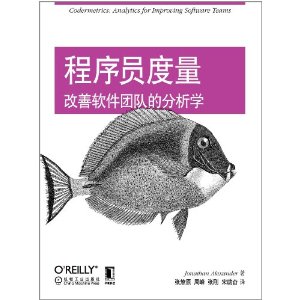IT界大多数管理者都是从一线研发走过来的,我也如此,虽然,我现在又在尝试成为一名合格的程序员。
很久以来的概念是,程序员的工作很难进行量化,你很难说写这一段代码真正需要花多少的时间,他坐在那里发愣,你很难说他是真的在发愣,还是在思考程序的逻辑实现,他的显示器屏幕在滚动,你很难发觉是他编写好的程序输出,还是他刚执行了几个less命令,或者执行了几个命令行批处理,打印出来应付你觉察的眼睛,他的键盘快速在响,你很难认为他不是在聊QQ或是在发微博….以致于有段时间,办公室里流传着程序员需要读一读《演员的自我修养》这样的笑话,程序员工作的量化,取决于他的演技水平。
又记得当年做team leader时,部门里实行TPE(Team Performance Evaluation)政策,定好诸多KPI,如完成的story points,支持其他团队次数,bug数量,bug修改时间,是否正确填写各种报表等等,每个迭代周期结束后,由分管的各种manager或owner打分,加权计算,最后得出一张团队绩效排名表,前三名给予奖励,而排在后面的总是工作在愧疚与难堪当中,不幸的是,我们组总是在这样的难堪中。我不敢妄加评论其好坏,只是在我们团队决心参与这场得分游戏后,我们连续获得了靠前的排名,但团队能力水平并没有因此而得到真正的提高,反而我有一种参与了这种斤斤计较的得分游戏的愧疚。
后来成为研发经理,对程序员度量这种事情更加萦绕在脑中,我一直很纠结于TPE给我带来的种种疑惑,曾带着问题请教过各路“大师“,也曾在社区活动中将这个话题提交到open space中与同行探讨,但结果总是不尽如人意,不是强调从人性的角度,提倡self management,就是从管理学的角度给我制定更多的KPI。
带着疑问和不解,经朋友介绍,看到了Codermetrics: Analytics for Improving Software Teams,我不能说这是一副包治百病的灵丹妙药,但是,多少帮助我澄清了心头的一些疑惑。看过《点球成金》(moneyball)这部电影的朋友可能会记得,当运动家队的总经理Bill因为资金的问题而陷入困境时,真正帮助他走出困境,走向巅峰的,不是哪个大牌球员,而是一个小小的数据分析员。他们认为一个出色的球队在哪些位置需要什么样的球员,定好球队的profile,然后从二线球员中,完全可以找出满足这个条件的球员,充实团队的profile,再根据数据做出相应调整,从而使球队获得了巨大成功。
《程序员度量:改善软件团队的分析学》 这本书无异于是软件开发行业中的《点球成金》,作者认为,软件开发同样如此,我们的目标是打造成功的团队,而不是blame某一个程序员的绩效表现。确定好这样的目标之后,围绕团队和组织的目标,我们知道成功的团队模型应该是怎么样的,这可以从已知成功的团队中抽象出来,由此选择需要的程序员个体进入这样的团队,适当做出调整,打造成功的团队。作者同样在书中,对团队成功从不同的维度进行度量,以确定度量指标。
而之于团队和程序员的度量,应该从多个维度进行,从产品类型的不同,从角色的要求不同等等,单一的数据可能毫无意义,但数据的组合可能会帮助我们发现隐藏在数据背后的洞察力。跟踪一段时间的响应度量,可以帮助我们对现实的工作做出调整,不断完善,做到可持续性。

主要内容包括:
- 学习如何通过程序员度量改变长期以来的假设,并且改善团队动态。
- 获得将程序员度量集成到现有流程的建议。
- 提出正确的问题来确定软件开发管理者需要收集的数据类型。
- 使用度量来测量一段之间之后的程序员个体的技能和团队效率。
- 确定每个程序员对团队所作的贡献。
- 分析对所开发的软件及其特性的响应,并且验证是否正朝着团队和组织目标而努力。
- 建设更好的团队,通过使用程序员度量来进行人员调整和补充。
此外,作者还是一个棒球迷,用各种与球类运动类比的手法,比较形象地把一些晦涩难懂的概念表达出来,从这一点看,还是比较吸引人的,起码不会读起来太枯燥。
作为一支球队,我们需要知道这些角色的组成应该达到一个什么样的水平,那么同样如此,软件开发团队也需要这样的角色来组成团队的profile。
作者将软件开发团队中的角色与球队当中的角色对应起来:
- 激励者,那些可真正激励团队,有助于凝聚团队的人,是团队的助推剂。
- 得分手,那些面对棘手难题,攻关能够迎上的人,攻克开发过程中的难题,在产品的实现中有较多产出的人。
- 防守专家,那些可以有助于保护团队免受外界干扰的人,如测试人员等,因为他们减少了团队bug的输出,从这个意义上来讲也是一个很好的防守。
- 全能队员,那些什么都可以做的蓝领们,哪里需要哪里搬,多能就是他们最擅长的事,不管是让他去做代码的编写,特性的测试,还是技术支持,他们都能做,我是团队一块砖,哪里需要哪里搬。
那么,我们需要如何定义度量指标呢,作者同样从体育运动中将一些概念延伸出来,对技能的度量有:得分,多能,火力,助攻,进攻影响力,救援,抢断,活动范围,防守影响力,失误,错误等。这样,我们可以很容易的定义出,什么样的程序员,他在这些度量指标上的分数如何?能够通过数据确定其后面的洞察力才是最牛B的事。
而对团队产品的度量,作者引用了响应度量:胜场,胜场速度,胜率,推动力,输场,输场速度,罚球,罚球胜场比,增益,增速,加速度,胜场排名,能力排名等。而不同类型的产品,其分数的分布也是不同的。
而最后定义的价值度量,是一种量化个体技能如何在团队中产生价值的指标:影响力,效率,领先份额,胜场份额,输场份额,团队合作,守场,爆发力,战斗力等,而团队在不同的成长阶段,其值的分布也是有区别的。真正的度量,应该是以团队建设为目标,好的度量会告诉我们团队目前在哪?团队的方向在哪?团队现在要解决什么问题?度量不是评级。度量的使用是一个不断试错的过程,建立良好的数据收集方式,选择性的挑选度量指标,评估结果并调整,建立可供讨论的平台是我们接下来可以做的事。
基于以上表述,个人觉得国内会有很多人与我有相同的问题需要解决,说不定这本书还能起到一些帮助。在朋友的鼓励下,应承下本书的翻译工作,但发现翻译工作真的是体力活,一是要求把原书的原意翻译给大家,二又得保证适合中文阅读习惯,工作量非常大,对于完全没有书本翻译经验的我来说,这是一个无法完成的任务,能找到最佳拍档真的很不容易,多谢有几位好朋友的加入,本书才得以完成出版,在这里要对他们三呼万岁,谢主隆恩。后来,圈子里的朋友告诉我,做外语书翻译是最吃力不讨好的事,翻得差了,被人骂,翻得好,读者会说是原作者写得好。现在想想,中文译本的书是否好读,不仅仅取决于原作者的水平,翻译者的贡献可谓功不可没。
